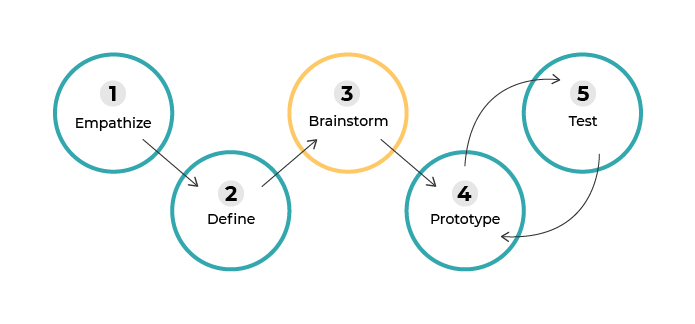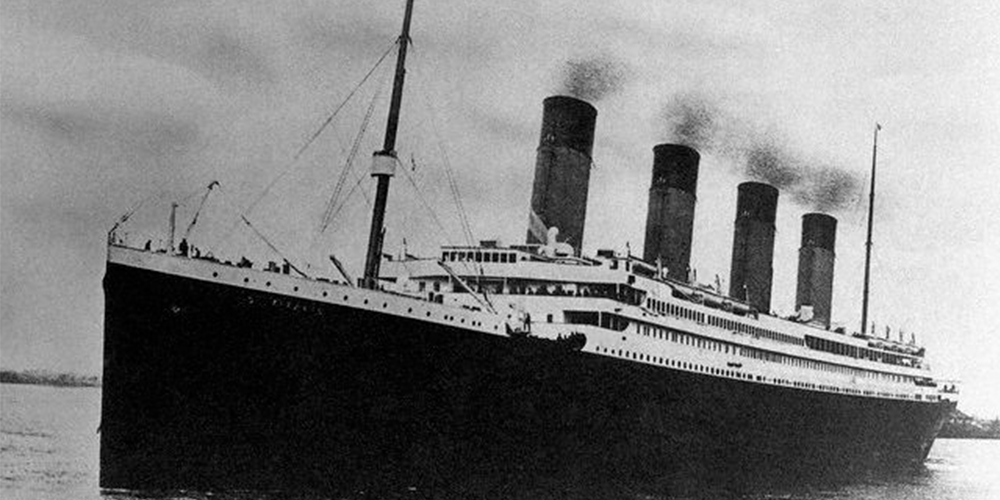Welcome to phase 3: Ideate (aka brainstorm). This is the phase where you look for solutions to the problem identified in the previous step.

This is perhaps the most exciting part of the process, so enjoy it!
You can do this part alone (although that can be lonely, so try to invite people to join in) or as a team.
Whichever you choose, you’ll need to do a bit of preparation before you start.
Prepare Your Brainstorming Session
To put the odds on your side, there are three main factors to take into account:
Using the right tools.
Adopting the right attitude.
The logistical aspect.
1. Have the Tools You Need Available
The session will go more smoothly if you have the right equipment:
Paper (loose letter-sized sheets).
Pens (enough for everyone).
Felt-tip pens or highlighters.
Sticky notes (preferably in several colors, one for each type of idea).
A whiteboard (if possible, otherwise use a wall, large table or a window).
2. Follow the Ground Rules for Effective Brainstorming
We tend to immediately dismiss ideas that don’t seem feasible, but at this stage, this is counterproductive. For the moment, we’re interested in the quantity, not quality, of ideas.
Write the following ground rules down or display them somewhere so that everyone can keep them in mind during the session:
3. Stay on Top of Logistics
To create the best possible conditions for your brainstorming session, make sure you:
Reserve/set aside a dedicated space where you won’t be disturbed (large enough for everyone to move around in—some studies show we think better when moving).
Appoint a facilitator (or mediator) who will:
make sure everyone follows the guidelines.
maintain the group’s enthusiasm and motivation.
mediate and facilitate discussion.
Fight Functional Fixedness Using Divergent Thinking
Being creative sometimes means being able to turn a problem around in your head and look at it from an angle that no one would have thought of.
This is called divergent thinking, because it’s different from the “standard” thinking process.
One of the best examples I’ve come across in recent years of a divergent thinking solution involves a plan for rescuing passengers from the Titanic shipwreck.
Curious?
Let me summarize it for you:
A little over a century ago, during the night of April 14, 1912, nearly 1,500 people died when the Titanic sank, and about 700 people survived—those who made it onto the lifeboats.

Lifeboats are the most obvious solution that springs to mind when a boat sinks in the middle of the Atlantic. But could there have been another way to limit the loss of life? Or even save everybody?
The answer is theoretically yes, but coming up with it would have required superhuman cool-headedness on the part of any designers, sea rescue ergonomists, and problem-solvers on board, and some serious divergent thinking skills in the midst of total chaos.
Let's go back in time and look at the facts:
The situation: the liner has hit an iceberg and sustained irreparable damage. It’s starting to sink.
Challenge: the passengers are going to end up in the water and may freeze to death or drown.
Objective: to save the passengers from hypothermia and/or drowning.
Solution: keep passengers out of the water so that they can avoid freezing water temperatures and be able to breathe.
Resources: use whatever’s available to rescue passengers; find floating objects.
Now take a few moments to think about the situation, alone or with your team, and you’ll probably come up with a whole range of resources to save the passengers.
First, you think of the lifeboats. That’s all well and good, but there aren't enough of them.
So, you start thinking about other types of floating objects: boards, doors, tires (there are hundreds of cars on board!). But these are relatively small and precarious objects, which can easily tip over in the water.
You might think of combining them. You could attach planks and doors to tires to make makeshift rafts.
But look around.. Isn't there another floating object available? Something big enough and strong enough for all passengers to fit on? Yep! The iceberg itself!

The iceberg that caused the sinking of the Titanic was relatively flat and was 120 meters long. The passengers could have used the few available lifeboats and been dropped off in batches. The liner could have potentially been moved closer to the ice to let the passengers climb onto it, etc.
The problem becomes the solution!
So why do we have such a hard time coming up with these kinds of solutions?
This means that it’s difficult to think of an object outside of the context we’re used to seeing it in.
Use effective techniques to generate ideas
On your mark, get set…brainstorm! (or ideate).

This step is all about generating as many ideas as possible.
As you can imagine, it’s useful to consider your challenge from all angles and use divergent thinking (as we touched upon previously) to come up with all sorts of ideas.
Apply business models that inspire you to your project
Take brands you like or find inspiring, like IKEA, Netflix, Blablacar, or Instagram, and ask yourself:
What would my project look like if I applied their model to it?
This can inspire a whole new set of ideas simply because you are looking at your challenge from a new perspective.
Example :
Imagine you're working on creating a new kind of school, and you decide to apply the Netflix model.
How would I apply how Netflix works to education?
In a nutshell:
A monthly subscription service with no commitment,
A library of interesting content,
Tracking of content consumed and recommendations of similar content.
Do the same with a different model (or a different concept, and you’ll have fields of possibilities open to you!
Add constraints to your concept
Try adding different constraints to your project, such as:
size
price
space
engagement
This will incite you to consider all types of service and product offerings.
Example :
What if I had 3000 m2 (32,292 sq. ft.) available—how would I organize the space? What about with 30m2 (323 sq. ft.)?
What would my school be like if tuition was very low? Or free? What if it was very high?
Contextualize your challenge
Drastically changing your target audience could elicit ideas you never would have thought of without the forced change of perspective.
Exemple :
What if it were a school for athletes?
Or a school for people over 65?
Or a school not for kids, but for parents?
What would this change?
But why does quantity take such precedence over quality here?
Because you need a large volume of ideas to find the great ones!
If you censor the ideas that seem unfeasible for the start, it’s impossible to:
think outside the box,
bounce off of other people’s ideas,
and in doing these two things, come up with creative, original ideas.
Quantity will lead you to quality!
Let’s Recap!
In the third step of design thinking, it’s quantity over quality! This will allow you to pick a diamond in the rough–a great idea or ideas that you’ll develop on.
To do this, it’s important to create a “safe space” for brainstorming: this is a judgment-free zone, both for your ideas and others’.
It’s essential to bounce off of your own or others’ ideas. You can use different techniques to do this, such as adding constraints or applying a model that inspires you.
Thinking divergently means casting aside the obvious ideas or solutions that come to mind to come up with original solutions that we wouldn’t necessarily think of intuitively.
In the next chapter, we’ll see how to wrap up a brainstorming session by choosing the solution that we will develop into a prototype.
